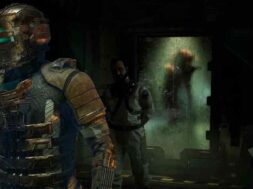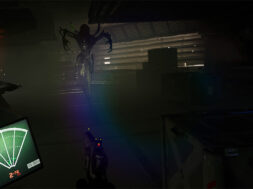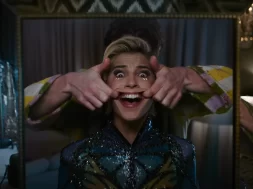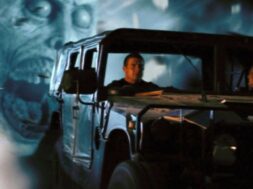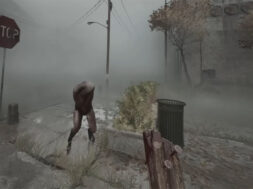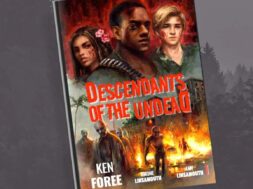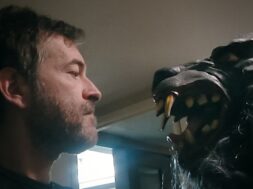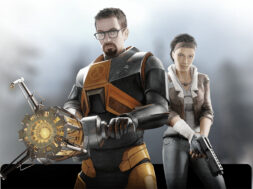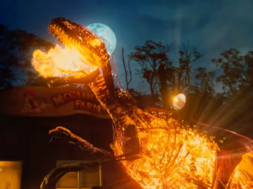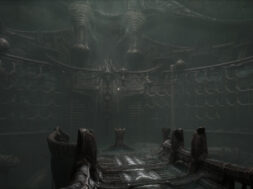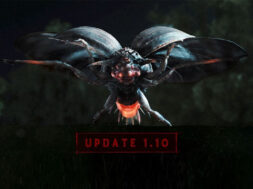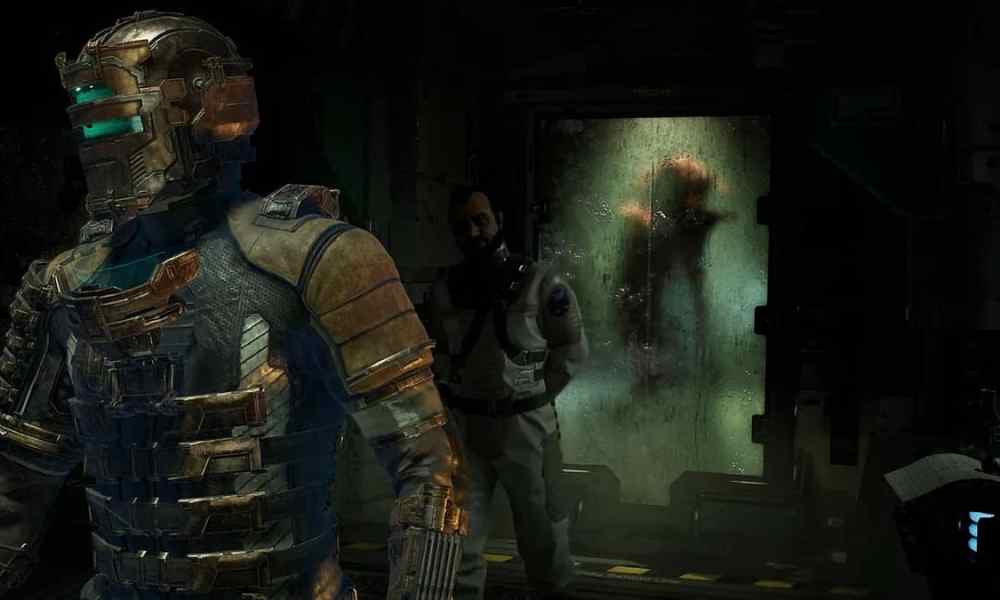
Since the genre’s inception, collectable documents have been a staple element of survival horror, found in everything from Silent Hill to Outlast. For years, resourceful developers have been using them to establish their worlds, tease upcoming threats, aid players in solving puzzles, and to tell self-contained stories.
Indeed, it is because these files are so versatile that we’ve dedicated a regular feature to them at Bloody Disgusting, in the form of this Dread Notes series. Here, we shine a spotlight on the most creative examples of in-game journals, audio logs, bestiaries, video clips and so on, with a view to exploring what they add to the overall experience. In this latest installment, we’ll be putting Motive Studio’s superb remake of Dead Space under the microscope.
Though they might seem ubiquitous today, there was a point in the late noughties when collectable documents had fallen somewhat out of fashion. In the wake of Resident Evil 4, the horror genre started to embrace a more actionized feel and that meant that there was far less time for things like reading or standing around listening to voice recordings.
Released back in 2008, Dead Space was arguably the poster-child for this sea change, as it placed a heavy emphasis on combat and gave you minimal downtime to explore. However, it still had its fair share of intriguing “database entries,” which Motive has now supplemented with brand new material for their next-gen update. Let’s take a look at some of the highlights.
Background Request
In original recipe Dead Space, Isaac Clarke was your quintessential silent protagonist, constantly deferring to co-workers (as well as to total strangers) and obediently following orders without ever taking the initiative for himself.
Sure, he had a thinly-sketched motivation — that being to reunite with his long-distance inamorata, Nicole — but he was otherwise just a blank slate for the audience to project themselves onto. Less of a fully developed character and more of a badass suit of armour. One that was fortuitously blessed with superhuman quadriceps, perfect for stomping on monsters.
By assigning him the odd line of dialogue here and there, Motive’s version does attempt to give Isaac a much-needed personality transplant. He now reacts appropriately to his hellish circumstances (beyond just monosyllabic grunts), chastises those around him when they make things difficult, and devises his own plans (rather than acting as a mere pawn in the machinations of others).
Yet despite being significantly fleshed out, a lot of his past remains shrouded in mystery. One way that players can rectify this, and learn more about their favourite interstellar handyman, is by skimming his employee background check.
Lying on the deck of the Kellion, this document sheds light on Isaac’s familial relationships, how he caught the engineering bug from his father, where he first met Nicole, and how his mother’s mental state fractured when he was younger, giving the opportunistic Church of Unitology a chance to sink their claws into her. In short, it makes him feel like a more rounded, three-dimensional protagonist.
Not to mention, it also makes clear why religion is such a sore topic for him.
Anonymised Transcript
The remake doesn’t neglect Nicole either, setting aside a lengthy questline that explores her stint as Chief Medical Officer aboard the USG Ishimura.
While tracking her movements around the planet cracker, observant gamers are likely to stumble across a record of one of her more psychologically-incisive sessions. Anonymised for the sake of doctor-patient-confidentiality, it archives a chat between Nicole and a skittish Jane Doe who was itching to get out from under the thumb of Unitology.
Having had a bad experience with this sort of thing in the past, Doctor Brennan begs her patient to prioritise their own wellbeing and to leave the cult immediately. Over the course of the ensuing transcript, we see the dynamic between our two speakers undergo a subtle role reversal, as Nicole goes from being the level-headed source of comfort to someone whose own vulnerabilities are on full display.
Towards the end, her speech becomes far less coherent, ellipses are peppered throughout the dictation, and sentences just trail off into pregnant silence. Clearly, she is reliving some kind of historic trauma related to the church and it is causing her to get more than a little frazzled.
When it comes to justifying this anxiety, all she can bear to say is: “I Had a patient who … I tried. And her son tried, so hard. But she…” If you’ve read the aforementioned background request, then you know that this is an allusion to Isaac and the terrible fate that befell his mother.
Although it is brief, parsing this document gives you plenty of insight into Nicole’s compassionate nature, her understandable mistrust of the church, and how she is wracked with guilt for failing those entrusted into her care. Not bad for a bit of optional reading.
Unitology Article
Continuing with the Unitology thread, this collectable takes the form of a searing exposé that delves into how the institution manipulatives its followers, and all of the shady goings-on that take place behind closed doors.
If you blitz through Dead Space’s campaign without digesting much of the lore or flavour text, then you’ll only have a vague inkling as to what unitologists believe. Surveying the mess they’ve made around the Ishimura, it is obvious that: A) they worship strange obelisks B) they’re a tad unhinged and C) that they really want to be made “whole again.” Other than that, the precise tenets of their faith aren’t elaborated upon much.
During Chapter 4, players can fill in some of the gaps by reading an article entitled Is Unitology A New Hope, or Just Another Scam? Believably written in terms of its language use, structure and tone, it feels like a credible piece of journalism that would actually exist in this world. More importantly though, it gets you up to speed with the doctrines of this furtive cult.
It reveals that, according to unitologist teachings, humanity is the product of intelligent design, proof of which is inscribed upon alien markers dotted all over the galaxy (like the one found on Aegis VII). Legend has it that, 200 years ago, a guy named Michael Altman accused the government of trying to cover this up but, when he blew the whistle, he was dismissed as a kook.
True believers are convinced that, if they can track down one of Altman’s fabled monoliths, then they will be able to unlock the secret to eternal life. The kicker being that you have to die first, so no one can authoritatively debunk it as a load of nonsense.
Contextualising the fanatical behaviour exhibited by the likes of Doctor Mercer, and giving you a better idea of what you’re up against, the document also has a bit of satirical fun at the expense of organised religion. It goes on to explain that Unitology has managed to infiltrate the highest echelons of society: seducing wealthy elites into the church (by convincing them to donate their vast fortunes so they can “ascend” its ranks); accumulating billions worth of stock options in major corporations; and using its influence to silence any critics who dare speak out against them.
Nothing at all like a certain, notoriously litigious sect in real life. One that also happens to believe in mankind having an extra-terrestrial lineage. Nothing like that at all.
Fired Up For Work
One of the coolest things about Dead Space is that all of its guns, bar the pulse rifle, are in fact repurposed engineering tools. They each have their own practical applications within the diegesis and, while you would certainly want to handle them with care, it makes total sense that they’d be lying around on a mining vessel.
For instance, the contact beam is used for extracting ore, the ripper is just an industrial saw, and the force gun is efficient at breaking down large rocks into smaller rocks. That they also happen to work well as monster-slaying implements is a happy coincidence.
The item descriptions for each weapon lend further credence to this idea, but there’s a terrific piece of environmental storytelling that really hammers it home. In Chapter 3, where you first pick up the flamethrower (previously a blowtorch that was used for thawing objects that had been left in freezing cold vacuums), you’ll see a workplace safety announcement urging you to be extra cautious with the apparatus.
Presumably, this sign was meant to instill readers with a sense of trepidation and respect for fire. After all, the graphic design, the imperative rhetoric and the way that red font is used to indicate danger, all make it feel like an authentic poster that you would see in a factory-type setting.
Of course, in the context of a necromorph outbreak, it has the opposite of its intended effect and gets you all giddy about the prospect of burning space zombies to a crisp.
Ore Storage Report
Resembling your garden variety “slasher” (only beefed up and considerably taller), The Hunter is one of the most daunting adversaries that you’ll come up against in Dead Space. With the ability to regenerate its tissue faster than even your force gun can strip it away, a dogged persistence that sees it chasing Isaac throughout the ship, and devastatingly powerful attacks, it’s the closest that the game has to a Mr. X or Nemesis-esque stalker.
For the original 2008 title, that was all you really needed to know, but the remake better acquaints you with this indestructible menace. In what is probably Motive’s single biggest addition, the new “Premeditated Malpractice” side quest gives you an opportunity to do a little digging into the Hunter’s origins. Suffice it to say, what you uncover in the process is deeply unsettling.
Chronicled over multiple database entries (that each leave you on a tantalizing cliffhanger), the story of Brant Harris is rife with both horror and intrigue. One of the first Aegis VII residents to display signs of madness after coming into contact with the marker, he accidentally murdered his nurse and was subsequently transferred to the Ishimura for psychological observation.
Although you might think that the colonist got off lucky here — given that he was evacuated from the planet mere moments before shit hit the fan — the reality is that he was in for a worse fate.
Of the opinion that Harris’ condition was really some kind of divine miracle, the fanatical Doctor Mercer began to groom his patient, convincing him that he had a higher purpose. Showing a flagrant disregard for the Hippocratic oath, Mercer performed various experiments on his new guinea pig in order to accelerate their metamorphosis into a Hunter, and to dispatch them on deadly errands.
An especially gruesome incident from later on in this tale was captured by an automated security recording, triggered after Harris was caught pilfering supplies from Ore Storage. Upon being confronted by a hostile crew member, who makes the grave mistake of calling him a ‘freak’, Harris forces the interloper into a nearby upgrade station. You know, one of those industrial-grade machines that are used to reinforce your armour in the game.
Apparently, that’s a grievous health and safety violation, because we then hear an alarm being omitted over the recording. Drowning out the victims howls of agony and the accompanying sounds of pulverised flesh, it chillingly warns: “Untrained personnel are not authorised to use the suit kiosk. […] Serious injury may occur”.
Sure enough, in the immediate vicinity of where we find the log, there’s a kiosk in an utter state of disrepair. Clogged with innards and assorted giblets.
The fact that this grizzly death is left to your imagination, only hinted at through a collectable audio file, makes it way more unsettling than it would have been if you witnessed it first-hand in a cutscene.
Bloody Graffiti
When The Callisto Protocol launched back in December, it was unavoidably compared to its older sibling Dead Space.
It’s easy to see why too, as Glen Schofield’s spiritual successor goes out of its way to remind you of the director’s former glories. Both titles rely on similar body horror ideas, feature overlapping mechanics, share roughly the same narrative beats, make use of near-identical HUDs, and have protagonists with biblically-derived names.
When two things bear such a striking resemblance, it’s only inevitable that they will be pitted against each other. And, unfortunately for The Callisto Protocol, this particular fight was one that it could never hope to win.
Even its tutorials pale in comparison to Dead Space’s! When introducing the core tentacle-shooting mechanic, Callisto insists on holding your hand to a frankly patronising degree. Bombarding you with instructive dialogue, on-screen reminders, and screenshot guides that jarringly pause the action for you mid-combat; the over-explanation here just shatters any sense of immersion.
Conversely, Dead Space takes an elegant approach to teaching you its rules, in a way that makes it feel like the newer and more sophisticated of the two games.
For veterans, it goes without saying that the most efficient way of killing a necromorph is to strategically sever its body parts. However, if this is your first time battling the undead hordes, you’ll need to acquire that lifesaving information from somewhere. It’s hardly innate human knowledge after all.
While there is an audio log that does the job quite nicely, the message is most economically delivered by some ominous graffiti right at the beginning of the game. Scrawled in blood, the four-word memo bluntly reads: “Cut off the limbs”.
There’s no guff or flowery expression for you to sift through, as the author wanted to get right to the heart of the matter before they too succumbed to the virus. Iconic for good reason, you’d be hard-pressed to find a more straight-to-the-point note in any video game. It truly makes every last syllable count.
Vital Personnel
Alongside religion, it seems that capitalism never changes either. After all, flaunting your wealth is still a viable shortcut to getting whatever you want in the 26th century, as evidenced by this bleak correspondence between two downtrodden medical professionals.
When one of the clinicians enquires as to why an affluent patient is being fast-tracked through the waiting list — over another, more urgent case — it exposes just how utterly fucked the corporate culture of this future is. As it turns out, Ensign Sable was a company investor and so was therefore entitled to preferential treatment.
Referring to the email’s subject line, the more senior member of staff clarifies the situation: “Here’s your clerical error: one of them bought CEC stock at the last purchase, one didn’t. Guess which was suddenly bumped up to vital personnel.” They then dissuade their colleague from raising an ethics complaint, by signing off with the defeatist mantra: “shit rolls downhill.”
This whole exchange serves to underline just how cruel the world of Dead Space was, even before the necromorphs arrived.
Supervisor’s Choice
As per survival horror tradition, the vast majority of ancillary characters in Dead Space have already kicked the bucket long before you have a chance to be formally introduced. There are a handful of fellow survivors, but even they tend to keep their distance from Isaac, only interacting with him from behind safety glass, across impassable ravines, or via the medium of futuristic skype calls.
The closest you ever get to meeting them is posthumously, whether that’s by accidentally stepping in their squishy remains or happening across a brutalised corpse. Often, this viscera is accompanied by some kind of message from beyond the grave, recounting the casualty final moments.
Harrowing short stories in their own right, one of the best examples of this is in Chapter 7, when you locate Supervisor Dallas on the mining deck. Or what’s left of him at least.
Like his Nostromo namesake, Dallas presumably didn’t have the most agreeable of close encounters because, when you find him, he’s been graphically dismembered. With only a torso and a single arm remaining.
Yet, as it turns out, most of those wounds were actually self-inflicted. By listening to the audio log he left behind, you discover that Dallas was infected with the necromorph virus just moments prior to his death. Sickened at the thought of hurting others, he then decided to take matters into his own hands and amputated himself using nearby mining equipment (impressively managing to cut off 3 of his 4 appendages before bleeding out).
In what amounts to a tragic suicide note, he reasons: “At least if I don’t have any limbs, then I can’t kill anyone when I’m infected.”
Having this related to us through an emotional voice note — as opposed to dry text — adds a more personal touch to the missive, as we can hear Dallas’ remorse upon accepting that he’s reached the end of the road. When he concludes the log by imploring whoever is listening to pass on a touching goodbye to his loved ones, it’s difficult not to feel a pang of sympathy.
That being said, he probably could have hit the stop button on the recording a few seconds earlier. You know, before he commenced with the self-mutilation. It just might have been nice to spare his family the screams is all I’m saying.
Z-Ball Rules
As an astro-engineer, Isaac’s Clarke has a tremendously high-pressure job. The work-life balance isn’t great, he’s lumbered with an unenviable amount of responsibility, and trying to keep a hulking spacecraft together (fixing the innumerable problems that keep cropping up) must be like playing the world’s most infuriating game of whack-a-mole.
It’s only natural that he’d need to decompress every now and then to keep it from all becoming too much. Given that hacking up mutant babies isn’t exactly the healthiest way to blow off steam though, he is forced to look for alternative leisure pursuits aboard the Ishimura.
Luckily for him, the crew deck has a lavish sports centre that serves as an effective distraction from the nightmare unfolding everywhere else on the ship. Here, you are able to play consecutive matches of something called “Z-Ball”; which is essentially a larger-scale, zero-gravity take on Skee-Ball.
In a nutshell, the objective is to score as many goals as possible in the allotted time frame, by using your Kinesis Module to launch objects through color-coded hoops. Of course, there’s a little more to it than that, as proven by the memo that’s posted on the court outskirts.
Detailing the Z-Balls rules, and how to claim rewards from the adjacent lockers, this document also gives you an invaluable tip on how to accumulate points faster. It recommends that: “when the centre of a ring lights up” you should target that specific goal zone for a multiplier.
If you heed this advice, then you’ll be able to breeze through the harder levels of the minigame and treat yourself to a bonus Power Node as a grand prize. Definitely a case where you want to read the instructions first then!
